

Religions of the ancient Near East.
Arabian mythology. Arabian mythology is the ancient, pre-Islamic beliefs of the Arab people.
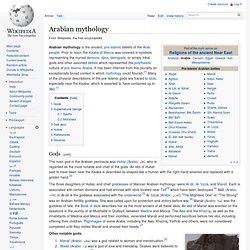
Prior to Islam the Kaaba of Mecca was covered in symbols representing the myriad demons, djinn, demigods, or simply tribal gods and other assorted deities which represented the polytheistic culture of pre-Islamic Arabia. It has been inferred from this plurality an exceptionally broad context in which mythology could flourish.[1] Many of the physical descriptions of the pre-Islamic gods are traced to idols, especially near the Kaaba, which is asserted to have contained up to 360.[1] Gods[edit] The main god in the Arabian peninsula was Hubal (Arabic: هبل), who is regarded as the most notable and chief of the gods.
An idol of Hubal said to have been near the Kaaba is described as shaped like a human with the right hand severed and replaced with a golden hand.[2] Babylonian religion. Babylonian religion is the religious practice of Babylonia.
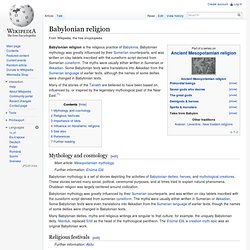
Babylonian mythology was greatly influenced by their Sumerian counterparts, and was written on clay tablets inscribed with the cuneiform script derived from Sumerian cuneiform. The myths were usually either written in Sumerian or Akkadian. Canaanite religion. Canaanite religion is the name for the group of Ancient Semitic religions practiced by the Canaanites living in the ancient Levant from at least the early Bronze Age through the first centuries of the Common Era.
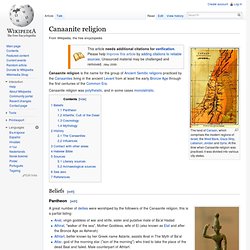
Canaanite religion was polytheistic, and in some cases monolatristic. Beliefs[edit] Pantheon[edit] Ba'al with raised arm, 14th-12th century BC, found at Ras Shamra (ancient Ugarit), Louvre. Elam. Elam was an ancient civilization centered in the far west and southwest of modern-day Iran, stretching from the lowlands of what is now Khuzestan (Luristan o Bakhtiari Lurs) and Ilam Province as well as a small part of southern Iraq.
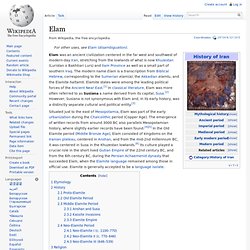
The modern name Elam is a transcription from Biblical Hebrew, corresponding to the Sumerian elam(a), the Akkadian elamtu, and the Elamite haltamti. Elamite states were among the leading political forces of the Ancient Near East.[1] In classical literature, Elam was more often referred to as Susiana a name derived from its capital, Susa.[2] However, Susiana is not synonymous with Elam and, in its early history, was a distinctly separate cultural and political entity.[3] Etymology[edit] The high country of Elam was increasingly identified by its low-lying later capital, Susa.
Geographers after Ptolemy called it Susiana. History[edit] Proto-Elamite[edit] Hittite mythology. Seated deity, late Hittite Empire (13th century BC) The understanding of Hittite mythology depends on readings of surviving stone carvings, deciphering of the iconology represented in seal stones, interpreting ground plans of temples: additionally, there are a few images of deities, for the Hittites often worshipped their gods through Huwasi stones, which represented deities and were treated as sacred objects.

Gods were often depicted standing on the backs of their respective beasts, or may have been identifiable in their animal form.[3] Overview[edit] Priests and cult sites[edit] Hurrians. The approximate area of Hurrian settlement in the Middle Bronze Age is shown in purple.

The Hurrians (cuneiform: 𒄷𒌨𒊑; transliteration: Ḫu-ur-ri) were a people of the Bronze Age Near East. They spoke a Hurro-Urartian language called Hurrian, and lived in Anatolia and Northern Mesopotamia. Ancient Mesopotamian religion. The god Marduk and his dragon Mušḫuššu Mesopotamian religion refers to the religious beliefs and practices followed by the Sumerian and East Semitic Akkadian, Assyrian, Babylonian and later migrant Arameans and Chaldeans, living in Mesopotamia (a region encompassing modern Iraq, Kuwait, southeast Turkey and northeast Syria) that dominated the region for a period of 4200 years from the fourth millennium BCE throughout Mesopotamia to approximately the 10th century CE in Assyria.[1] Mesopotamian polytheism was the only religion in ancient Mesopotamia for thousands of years before entering a period of gradual decline beginning between the 1st and 3rd centuries CE.
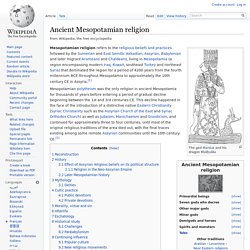
Persian mythology. Persian mythology are traditional tales and stories of ancient origin, all involving extraordinary or supernatural beings.

Scythian religion. A collection of drawings of Scythian stelae, ranging from ca. 600 BC to AD 300.

Many of them depict warriors, apparently representing the deceased buried in the kurgan, holding a drinking horn in their right hand. Scythian religion refers to the mythology, ritual practices and beliefs of the Scythians, an ancient Iranian people who dominated Central Asia and the Pontic-Caspian steppe in Eastern Europe throughout Classical Antiquity. What little is known of the religion is drawn from the work of the 5th century Greek historian and ethnographer Herodotus. Scythian religion is assumed to have been related to the earlier Proto-Indo-Iranian religion, and to have influenced later Slavic, Hungarian and Turkic mythologies, as well as some contemporary Eastern Iranian and Ossetian traditions.
Archaeological context[edit] The primary archaeological context of horse sacrifice are burials, notably chariot burials, but graves with horse remains reach from the Eneolithic well into historical times. Ancient Semitic religion. Ancient Semitic religion encompasses the polytheistic religions of the Semitic speaking peoples of the ancient Near East and Northeast Africa.

Its origins are intertwined with Mesopotamian mythology. As Semitic itself is a rough, categorical term (when referring to cultures, not languages), the definitive bounds of the term "ancient Semitic religion" are only approximate. Proto-Semitic pantheon[edit] Abbreviations: Ac. Akkadian-Babylonian; Ug. Sumerian religion.